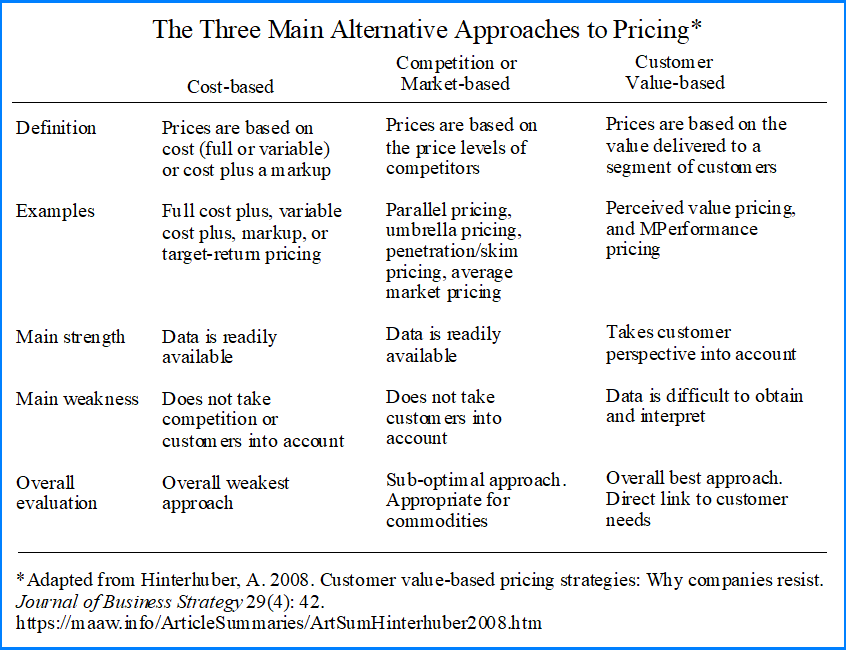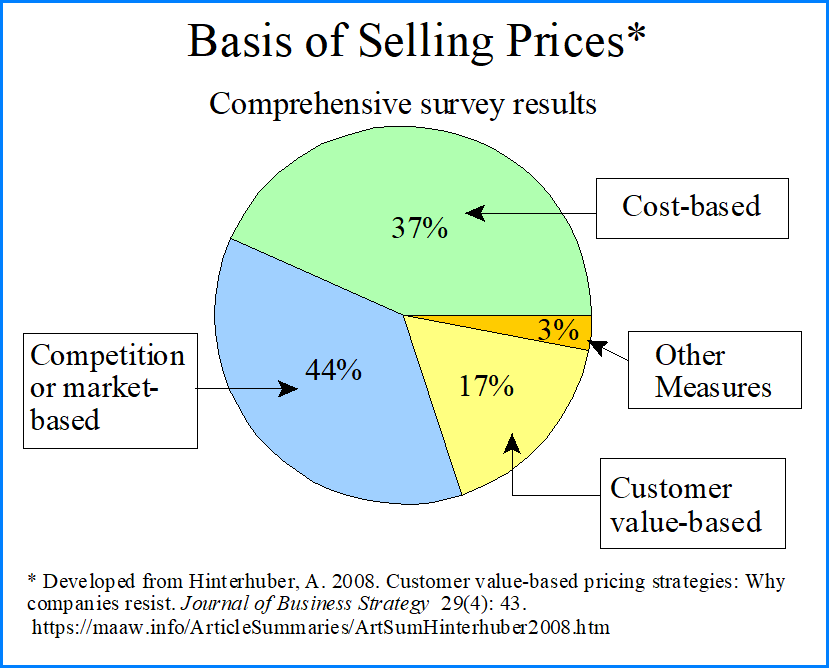
Summary by James R. Martin, Ph.D., CMA
Professor
Emeritus, University of South Florida
Pricing Decisions Main Page |
Surveys Main Page
Pricing strategies generally fall into three categories: Cost-based pricing, competition or market-based pricing, and customer value-based pricing. Although customer value-based pricing has been recognized in the marketing and strategy literature as the overall best approach to pricing, a fairly comprehensive literature review indicates that it has not been widely implemented in practice. This apparent inconsistency between theory and practice provided the motivation, and subsequent purpose of this study, i.e., to provide research findings regarding the major obstacles that prevent companies from effectively implementing value-based pricing. The author begins by presenting the theoretical background of the study that includes the three main alternative pricing strategies, and the frequency of their implementation. This is followed by a description of the research methodology of the current study, a presentation of the research findings, and some recommended remedies.
Pricing Strategies
The three main pricing strategies are compared in the table presented below. Although data is readily available for cost-based pricing, this strategy does not include competition or customer value in the pricing decision. It is the overall weakest approach to pricing. Competition or market-based pricing is a somewhat better strategy because it includes consideration of competitive prices, but it does not include the value derived by customers. Customer value-based pricing is considered the best overall approach because prices are based on the value delivered to customers, although data related to customer value is difficult to obtain and interpret.

Implementing Different Strategies
To determine the adoption level of each of the pricing strategies, the author calculated the averages based on all the published literature on pricing approaches used in practice from 1983-2006. This included nearly two dozen studies conducted in the U.S., Europe, and Asia covering a broad range of industries. The results of these combined surveys are illustrated in the graphic below. Competition or market based approaches were dominant at 44%, followed by cost-based approaches at 37%. Although considered the overall best method, customer value-based approaches were used by only 17% of the respondents.

Research Methodology
To determine why customer value-based pricing is so rarely used in practice the author developed a questionnaire using cluster analysis to summarize the results of nine pricing workshops conducted with focus groups of business executives at nine different companies in Germany, Austria, China, and the USA. Clustering the responses to questions related to the implementation of value-based pricing generated six main obstacle categories. Value assessment, value communication, market segmentation, sales force management, top management support, and other factors.
1. Difficulties in making value assessments: Value assessments or analysis can be obtained from expert interviews, customer focus groups, conjoint (or trade-off analysis), assessment of value-in-use (actual customers who are using the product), and customer questioners related to their satisfaction with new product attributes. (See the Dummer, W., M. Masters and D. Swenson summary below).
2. Difficulties in communicating value to customers: Communicating value to customers involves advising them about the product's features, the benefits the product provides, and the benefits that are in accordance with their needs.
3. Difficulties with market segmentation: Dividing customers into groups or segments is implemented by focusing on customer needs as the primary segmentation variable. For example Monsanto identified three segments as price-driven, mainstream, and technically sophisticated.
4. Difficulties with sales force management: Value leakage occurs when sales teams extend discounts to customers to meet sales targets or for other reasons. Guidelines need to be established to avoid unnecessary discounts including the level of authority for sale discounts, sales force remuneration systems, fixed and variable remuneration systems, sales force training, and sales force monitoring.
5. Difficulties with senior management support: Obtaining senior management support involves lobbying, networking and bargaining.
After the various obstacles have been overcome, companies will be able to more easily implement a value-based pricing strategy that is recognized as a key to profitable pricing.
________________________________________
Related summaries:
Abel, R. 1978. The role of costs and cost accounting in price determination. Management Accounting (April): 29-32. (Summary).
Bertini, M. and O. Koenigsberg. 2021. The pitfalls of pricing algorithms. Harvard Business Review (September/October): 74-83. (Summary).
Dummer, W., M. Masters and D. Swenson. 2015. Delivering customer value through value analysis. Cost Management (March/April): 17-24. (Summary).
Govindarajan, V. and R. N. Anthony. 1983. How firms use cost data in price decisions. Management Accounting (July): 30-31, 34-36. (Summary).
Hinterhuber, A. and S. Liozu. 2012. Is it time to rethink your pricing strategy? MIT Sloan Management Review (Summer): 69-77. (Summary).
Hughes, S. B. and K. A. Paulson Gjerde. 2003. Do different cost systems make a difference? Management Accounting Quarterly (Fall): 22-30. (Summary).
Martin, J. R. Not dated. Chapter 11: Conventional Linear Cost-Volume-Profit Analysis. Management Accounting: Concepts, Techniques & Controversial Issues. Management And Accounting Web. Chapter11.
Martin, J. R. 2022. A note on pricing strategies. (Note).
Porter, M. E. 1980. Competitive Strategy: Techniques for Analyzing Industries and Competitors. The Free Press. (Summary).
Shim, E. and E. F. Sudit. 1995. How manufacturers price products. Management Accounting (February): 37-39. (Note).
Shim, E. D. and R. Lim. 2022. A survey of U.S. firms' pricing strategies and costing methods. Cost Management (May/June): 15-19. (Note).
Thurston, K. L. D. M. Keleman and J. B. MacAarthur. 2000. Providing strategic activity cost information: Cost for pricing at Blue Cross and Blue Shield of Florida. Management Accounting Quarterly (Spring): 4-13. (Summary).